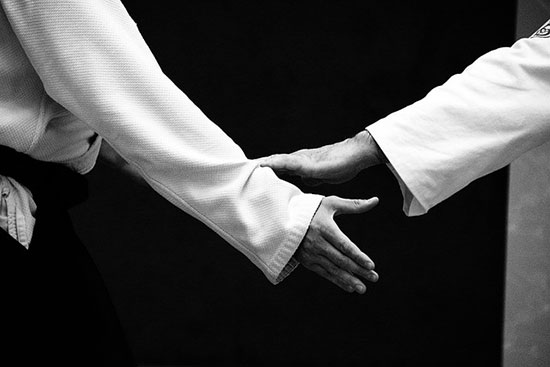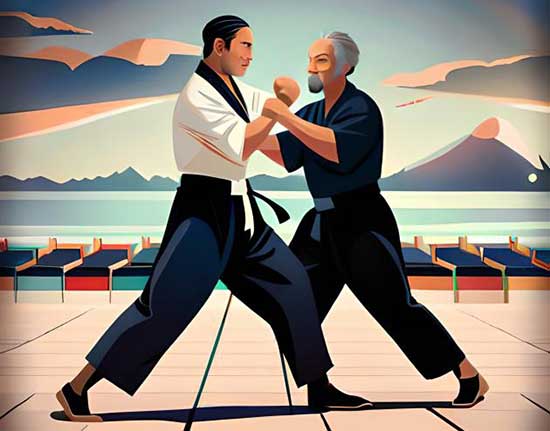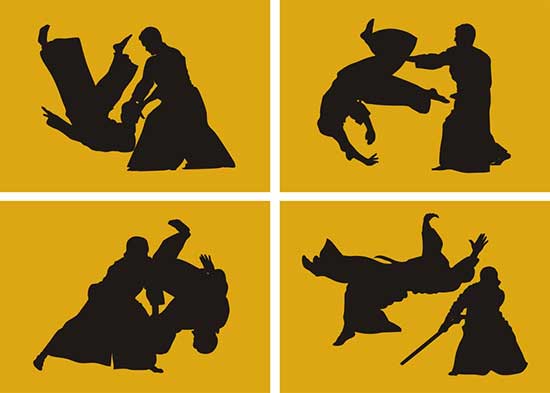Aikido is an ancient martial art that focuses on using your opponent’s energy to disarm them. The term “Aiki” in Aikido refers to the principle of harmony and flow between physical and spiritual life, which can be broken down into three elements: heaven, earth, and humanity.
The goal of Aikido is to integrate these different aspects of life by flowing with a partner’s attack so that their power is ultimately neutralized through reciprocity.
Contents
List of Aikido Defense Techniques
Aikido defense includes a range of techniques that entail escaping grab holds, disarming your attacker, and returning their energy onto them using joint locks, throws, and pins.
Though these self-defense moves may look quite impressive (especially when they involve throwing a lot of people at once), it’s important to remember that Aikido is intended to be used against one attacker at a time. The techniques involve
1. Throws
Aikido throws are designed to disarm your attacker. They are intended to be performed while standing up.
In more instances, an Aikido practitioner is taught to hold the attacker in a lock after the throw in order to control them. There are several throw techniques to employ;
Irimi Nage– an “Entering Throw” that involves stepping into your attacker and redirecting their momentum to throw them over your hip.
Kaiten Nage– Also referred to as the ”wheel throws”, kaiten nage entails a clockwise circular movement of your body to knock your opponent off balance.
Tenchi Nage– Renowned as the ”Heaven And Earth Throw,” Tenchi is a circular throw in which you turn and throw your attacker, using your own body weight to throw them.
Aiki Otoshi– ”Blending Drop” in which you slip under your attacker’s arm, then use the palm of your hand to send them to the ground.
Koshi Nage– ”Hip Throw” in which you throw your attacker over your hip while they are on one side of you.
2. Joint Locks
Joint locks are techniques that use leverage to control your opponent’s movements and cause pain or damage through pressure on their joints and ligaments.
Aikido joint locks are utilized to neutralize a grab hold or other forms of attack from an attacker. They involve rotating or twisting the opponent’s joint in order to lock it in place and break their balance, enabling you to disable them and control their body with ease.
Popularly used joint lock techniques include;
Ikkyo– ”First Contact” in which the attacker’s wrist is grabbed, twisted, and pulled, causing discomfort or pain.
Sankyo– Similar to ikkyo, sankyo involves grabbing your opponent’s wrists and twisting them back and forth.
Shihōnage– Referred to as the ”Four Direction Throw”, shihonage entails throwing your opponent while they are in a grab hold by twisting their arm and then throwing them over your shoulder.
Nikyo– ”Gentle Nail” refers to grabbing your opponent’s wrists, twisting them around, and then throwing them over your shoulder.
Kote Gaeshi– The ”wrist reversal”; involves grabbing your opponent’s wrist, spinning them so that you are in front of them, then forcing their arm behind their back and making it difficult for them to move.
3. Pins
Pins are the third form of Aikido defense techniques. They entail holding your opponent in place on the ground by controlling their body with your weight on top of them or by locking down one of their limbs and forcing a lock or a submission hold.
By using your body weight as additional leverage against an attacker, you can effectively disarm them or pin their arms until help arrives, giving you a chance to escape safely.
4. Chokes
Aikido and martial arts, in general, use plenty of chokes in their training curriculum. These are frequently used to subdue an attacker by causing them to pass out or lose consciousness.
Although these techniques may appear dangerous, they don’t cause lasting damage like the joint locks or pins do and are particularly useful for counter-attacking against multiple attackers.
One of the most popular defense technique for chokes in Aikido include;
Rear Naked Choke– This is a particularly effective choke that involves holding your opponent in an arm lock while wrapping your arm around their neck to apply pressure to the carotid arteries.
Other Controls Used to Enhance Aikido Techniques
Initial Controls
Head and Arms Control- By grabbing your opponent’s head and restraining it with one arm, you can rest the other arm across their chest in order to apply an effective control hold.
This makes it very difficult for your attacker to continue attacking you because they can’t effectively use their hands or arms to strike you.
Arms Control- You can use a brace arm hold to restrict your opponent’s movement by holding one of their arms outstretched while the other is held behind their back.
Footwork
The best way to avoid an attacker is to use stealthy, quick footwork against them. You can follow your attacker or sneak up on him by moving through the space he has just occupied and then reappearing behind him.
Aim for a position where you could attack him if he turned around but not if he moved in the same direction as you.
Using some foot angles, 90 Degree Pivot, 180 Degree Turn, and the Split S move are good ways to avoid or evade an attack while keeping yourself out of the attacker’s reach.
Conclusion
Aikido practitioners (ukemi) learn how to take an attacker’s force and redirect it into a throw or lock. This art is based on the principle of non-resistance, as opposed to other martial arts like Jiu Jitsu, which relies on resistance.
A traditional Aikido class will have you practice movements such as forms, stretches, and throws that teach this skill set.
Even though it is a martial art, Aikido is still considered a “soft” martial art. Most Aikido practitioners are usually taught to turn the other cheek and strike only after attempting to avoid an attack.
They are also taught to focus on controlling the attacker’s movement and not striking or using force in an attempt to harm them.




